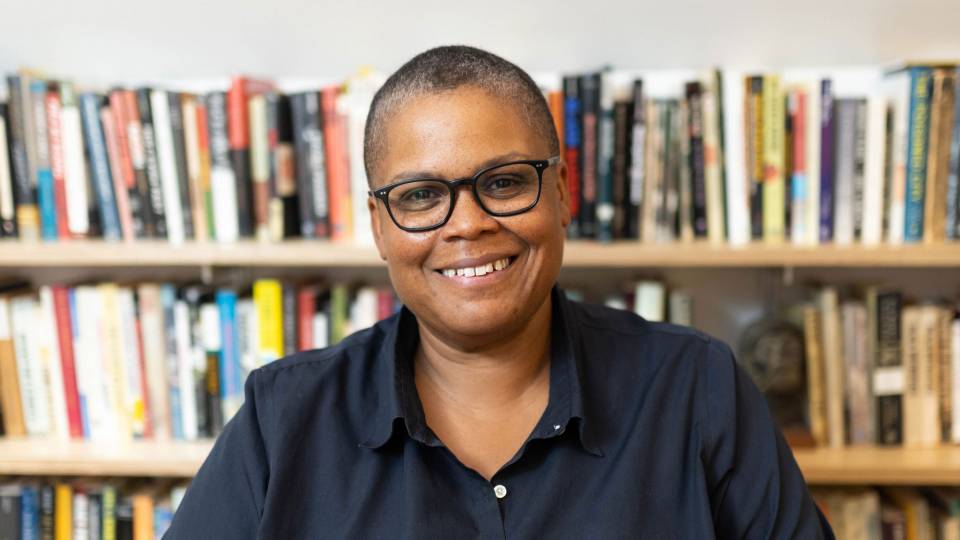Predatory lenders. Subprime and no-doc loans. Mortgage-backed securities. Mass foreclosures that disproportionately affected minority homeowners. Sound like 2008? It was 1972.
The subprime-mortgage crisis was nothing new, at least for America's poor urban communities. In the late 1960s, the United States government, reeling from violent civil-rights protests, enacted a plan to encourage homeownership among poor and low-income residents, most of whom were African American. But the program, a partnership between public agencies and private enterprise, quickly became rife with corruption. The result was eerily prescient of the recent housing crisis.
Keeanga-Yamahtta Taylor, a Princeton assistant professor of African American studies, became fascinated by this little-remembered era as a graduate student. She was living in Chicago and was already a fierce proponent of social justice — she attended her first demonstration at age 16, in support of women's reproductive rights. She has brought that tradition of activism to her position at Princeton where, within a year of being hired, she wrote her first book, touching on how structural inequalities embedded in American society and its institutions have fueled the Black Lives Matter movement. The book, "From #BlackLivesMatter to Black Liberation" (Haymarket Books, 2016), received the 2016 Lannan Foundation Freedom Award for an Especially Notable Book.

Keeanga-Yamahtta Taylor, an assistant professor of African American studies at Princeton, found that a 1970s program aimed at helping low-income urban and minority residents become homeowners led to predatory lending and mass foreclosures. (Photo by Denise Applewhite, Office of Communications)
The fact that inequality continues to permeate society some 60 years after the dismantling of discriminatory laws comes as no surprise to Taylor. As a student in the 1990s at a predominantly black high school in Buffalo, New York, she recalls being told by a white teacher that the students "would all be on welfare" if they didn't learn to respect authority. During a parent-teacher conference, the teacher threatened to call the police to remove her father, who was a university professor. "When my dad brought up what he wanted to discuss, she said she was not interested in the discussion," Taylor said. "My father made an incredulous remark — I don't remember what it was — and she used a phone in her classroom to call police who had an office in the school."
Although she enrolled in college directly after high school, Taylor was restless, and after a year, she dropped out and moved to New York City to pursue writing. She continued to demonstrate against social injustice, protesting police brutality in the city. A relationship led her to move to Chicago, where she and her partner joined efforts to repeal the death penalty.
A turning point for Taylor came in 2000 when these efforts paid off: the governor of Illinois placed a moratorium on executions. "It was an important moment for me because I saw the results that can happen when people advocate for change," she said. At 29, she decided to finish her undergraduate degree and enrolled at Northeastern Illinois University in a program for returning adult students.
Taylor already knew she wanted to study housing disparities and race when she entered graduate school at Northwestern University. "I was fascinated by how rigidly segregated Chicago is," Taylor said. "The black areas stretch for miles, and you can walk for blocks without seeing a white person."

Taylor’s book, "From #BlackLivesMatter to Black Liberation" (Haymarket Books, 2016), received the 2016 Lannan Foundation Freedom Award for an Especially Notable Book. (Image courtesy of Haymarket Books)
Through her work as a community organizer, Taylor had learned about the housing policies that shaped segregation in Chicago and the nation. The government's post-World War II emphasis on homeownership favored purchases in newly built suburbs. Many black families could not afford to buy in the new suburbs, and those that could endured blatant discrimination from realtors. The government considered urban areas to be "high-risk," so these areas didn't qualify for federally insured loans, a policy Taylor described in her doctoral dissertation as "racial judgments cloaked in the garb of objective economic analysis."
The civil unrest of the 1960s brought attention to the crisis of dilapidated and unsafe housing in urban America. In response, President Lyndon B. Johnson in 1968 announced that the government would extend its pro-home buying policy — including federally insured loans — to low-income purchasers. The hope was that a new cadre of urban residents, spurred by the pride of homeownership, would fix up neglected dwellings and catalyze urban renewal from within.
The new program would accomplish this through the creation of a "federally chartered private, profit-making housing partnership." Under the program, called Section 235, the private sector would provide the real estate agents, appraisers, mortgage brokers and financing, while the Department of Housing and Urban Development (HUD) would oversee the process.
Flaws emerged almost from the outset. One was that the responsibility for vetting a potential homeowner's creditworthiness fell to parties that had little stake in making sure people could afford the loans. Traditional banks and savings-and-loans stayed away from the new borrowers — they were considered too risky. Instead, a new type of lender, the mortgage broker, stepped in and began to pool loans that were resold as investments known as mortgage-backed securities.
By 1971, new infractions had surfaced. Owners found that the homes had more than cosmetic problems, including "faulty plumbing, leaky roofs, cracked plaster, faulty and inadequate wiring, rotten wood in the floors, staircases and porches, lack of insulation and faulty heating units," according to a HUD report. "About one-quarter were in such poor condition that investigators concluded that they should have never been insured," wrote Taylor in her dissertation.
It emerged that real estate speculators were buying cheap and uninhabitable properties and quickly "flipping" them for sale under the Section 235 program. A HUD internal report found that real estate agents, property appraisers and mortgage brokers colluded to artificially inflate prices for buyers. "No-doc" loans — issued without checking income statements and other documents — were common because lenders stood to make more money when a borrower defaulted due to the federal insurance payout. The report called attention to the biased attitudes of HUD officials toward the potential homeowners, suggesting that race played a role in letting the abuse happen.
The program came to an end in 1973 when President Richard Nixon declared a moratorium on subsidized housing programs, citing the corruption and disarray. A new narrative emerged that enabled the government to distance itself from programs to help provide homeownership in the inner cities: Poor people were too irresponsible to own homes and to revitalize their own communities.
This new narrative ignored the evidence — documented in HUD reports, hearings before Congress and major newspapers — that property speculators, real estate agents, appraisers and mortgage brokers lured poor and predominantly African American people into buying homes they could not afford. By mid-1975, the foreclosures were mounting. Foreclosure rates were seven times higher in the low-income housing programs than they were in the conventional home-lending market. According to newspaper reports, the government had paid more than $4 billion in insurance claims since the start of the program.
Yet, few people were indicted or censured for these failings, Taylor found. One reason was the close relationship between the private sector and HUD. According to a government report, the president of the Mortgage Bankers Association had personally helped write HUD regulations.

In 1965, President Lyndon B. Johnson signed the bill establishing the Department of Housing and Urban Development, which aimed to make affordable housing available to all. (Photo courtesy of the Lyndon Baines Johnson Presidential Library)
In archives held at the Hoover Institution at Stanford University, Taylor found the personal correspondence of Carla Hills, HUD director during the mid-1970s. The files were a treasure trove — an insight into what HUD officials were thinking during the height of the scandal. What Taylor found surprised her.
"There was a reluctance to discipline lenders and private-sector companies because of the fear that too much regulation would discourage participation in HUD programs," Taylor said. "There also was a discussion of HUD employees' concerns that they would be risking their ability to get jobs in the private sector. It was a surprise to me to find an open, written discussion of these issues."
This and other evidence has helped inform Taylor's viewpoint that private enterprise has no business shaping or implementing public policies. "In my opinion, those two spheres are very different," she said. "Private enterprise is about making profits, while the public sector was created to protect the public's welfare. As my work shows, public-private partnerships have a history, and this history should be included in the discussion about the best approaches to providing necessities such as water, health care, education or housing."
Taylor earned her doctorate and published her dissertation, "Race for Profit: Black Housing and the Urban Crisis in the 1970s," in 2013. She began as a faculty member at Princeton the following year, and she continues her work as an activist through her writing, lectures and community involvement. She is now writing a book about her housing research.
Her combination of high-quality research and her drive to bring her findings to the broader public are needed to make sure past policy mistakes are not repeated, said Taylor's Ph.D. adviser, Martha Biondi, a professor of African American studies and history at Northwestern University.
"Questions around finance and lending have been critically important in our own recent recession, and Keeanga brings a sharp historical lens to an issue that has been forgotten and neglected in most histories of the 1970s," Biondi said. "In a society that celebrates homeownership, Keeanga's work is a cautionary tale about the ways in which homeownership can be used to exploit poor and working-class communities."
Taylor's work underscores the importance of research in shaping public policy, said Eddie Glaude Jr., Princeton's William S. Tod Professor of Religion and African American Studies and the chair of the Department of African American Studies.
"Keeanga's work reveals in really powerful ways the unintended consequences of these public-private partnerships to solve the crisis of housing for low- and moderate-income families," Glaude said. "You come away from reading her work with not only a sense of the disaster that that decision was, but also the importance of understanding its social and historical overtones."
Taylor's research on structural discrimination in housing, combined with her ongoing work as an activist, led her to consider how Americans can move beyond inequality to build a society where people are treated fairly and not on the basis of racial stereotypes, a topic she tackles in "From #BlackLivesMatter to Black Liberation."

"The Civil Rights Movement addressed legal discrimination, but it also revealed that the problems confronting African Americans were not just Jim Crow laws — they were the practices and customs of racial discrimination that weren't written in law, that were found in real estate or banking or employment," Taylor said. "The outcome has been that African Americans suffer disproportionately in the areas that determine the quality of one's life."
The Black Lives Matter movement has brought much-needed awareness to the structural and institutional forms of racism in American society, she said. "We've become accustomed to thinking of racism as acts by individuals. But putting the blame on the individual suggests that racism can be overcome by education alone."
Instead, Taylor reminds us that throughout history racism has been used as a way for the powerful to control others for material gain — and it is still used that way. "Unless you address the way society is organized, you won't dismantle that power structure," Taylor said. "Patterns, unless actively undone, replicate themselves.
"Knowledge alone will not reverse this."
This article was originally published in the University's annual research magazine "Discovery: Research at Princeton."




